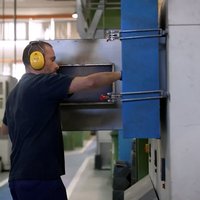The shape of the ball
How many hours are spent here and there discussing football. But I’m sure you haven’t noticed this approach to football at all. The relationship between football and mathematics. The roundness of the ball is not disputed. But, looking back at the story, we noticed that the balls at the beginning were not completely round. The shape of the soccer ball that we have today is the result of an evolution, and we will explain this by playing with mathematics.
Man has been kicking the football ball for two thousand years. In ancient Greece, Mexico, Italy or China they entertained themselves by playing with the round artifact. This, for example, is the oldest ball that is stored. It was found in a castle in Scotland and is about 1500. The balls have always been round, but today they are more round, with the help of mathematics.
IÑAKI LETURIA; Elhuyar Foundation: Jose, you give the ball a mathematical explanation. We see the ball, and you see the geometry.
José Ignacio Royo; mathematician, UPV/EHU: Yes, what I see here is, on the one hand, how polygons (pentagons and hexagons) come together to form a polyhedron.
This polyhedron also has its own name: the chopped icosahedron. There are other designs, but this is the most commonly used to make balloons. For what reason?
There are platonic loves, and there are also platonic solids. Platonic solids are spherical polyhedrons based on regular polygons, i.e. volumes that are constructed by summing triangles, squares or pentagons, where the same number of faces are summed at each vertex. It's only five. These volumes have been the starting point for the design of balloons with the help of mathematics throughout history. The cube, for example, is a platonic solid.
José Ignacio Royo; mathematician, UPV/EHU:For example, let's take a cube
IÑAKI LETURIA; Elhuyar Foundation:Well, it's not very round...
José Ignacio Royo; mathematician, UPV/EHU: Well, no, but if we exaggerate a lot, it rounds up. It occupies a certain volume within a sphere, but if we take it, for example, an icosahedron, it is more rounded; if we imagine the sphere that surrounds it, the percentage it occupies is much higher.
The Athletic Club Museum is a good place to learn about the history of the roundness of the ball. In the old photos you can see very well the development that it has had... And surprisingly, there were round balloons based on the cube.
IÑAKI LETURIA; Elhuyar Foundation: That's nice, this is based on the cube structure, isn't it? A dice, after all.
José Ignacio Royo; mathematician, UPV/EHU: Yes, the three parts come together to form a square, and the six sides come together as squares in the cube structure...
IÑAKI LETURIA; Elhuyar Foundation: Also mathematics, geometry.
José Ignacio Royo; mathematician, UPV/EHU: Yeah, it's a platonic solid after all.
IÑAKI LETURIA; Elhuyar Foundation: If this was from 58, this was older, from 1950.
José Ignacio Royo; mathematician, UPV/EHU: And structurally similar, beautiful, cubic also this.
On the way to roundness, in 1970, a great leap occurred: the cube was discarded and the cut icosahedron was expanded, a development of the icosahedron.
José Ignacio Royo; mathematician, UPV/EHU: Suppose that this icosahedron is made of cheese, and we cut it from here; if we took away this vertex, the base of the pyramid would be stopped, that is, a pentagon, and doing this on all the vertices, the triangles become hexagons.
IÑAKI LETURIA; Elhuyar Foundation: And then we'd get the ball.
The cut icosahedron fills 86% of the sphere; this without swelling. Once inflated, it reaches 95%. Mathematically and in the simplest way, it is the form that is closest to the sphere. Of course, if the polyhedrons are more rounded, they are obtained by using combinations of many polygons. For example, the unswollen, decahedral rhombicide occupies 94% of the sphere. It is expensive to produce: it has 120 sutures, while the cut icosahedron has only 90.
There is also such a polygon in nature. What is the cheapest structure for man is the most balanced and efficient for nature. Hexagons and pentagons are used to build the shell by a variety of sea urchins, and one of the most stable carbon structures has a cut-out icosahedron appearance. Is that a coincidence? No, the math.
José Ignacio Royo; mathematician, UPV/EHU: See, we have hexagons and pentagons. Pentagons can come together in three, and so on, we'd get a dodecahedron, one of the platonic solids. But if we take, for example, three hexagons, joining the edges...
IÑAKI LETURIA; Elhuyar Foundation: No volume is obtained.
José Ignacio Royo; mathematician, UPV/EHU:Exactly, it's flat.
This has been known for almost 2000 years. The Greek mathematician Teeteto proved that there are only five platonic solids, that it is impossible to make a form constructed of pure hexagons.
José Ignacio Royo; mathematician, UPV/EHU:What we have seen there is also seen here, we know that this is a flat angle.
Some graphic designers seem to be unaware of this. Do a Google search and to! First result, a ball made of hexagons. There are also more examples that contradict mathematical logic, such as the Champions logo.
José Ignacio Royo; mathematician, UPV/EHU: The design of the real Champions League ball is based on this form. Each pentagon has a pentagonal star drawn, which is why pentagonal stars come together in triples. But another thing is what happens in the logo; here they are joined by launches! That's weird...
IÑAKI LETURIA; Elhuyar Foundation: The impossible is...
And it's not the only mathematical rule that breaks it. Euler is not a German football player; he was a Swiss mathematician who discovered the formula that is fulfilled in each and every spherical polyhedron, for example the cube. The formula says: vertices minus edges plus faces, always come out two... but not here. In any case, the representation of the champion would be the following.
In modern balloons, such as Jabulani, there are no hexagons and pentagons. They give the material a round shape with the help of heat.
IÑAKI LETURIA; Elhuyar Foundation:I mean, it's a trap...
José Ignacio Royo; mathematician, UPV/EHU: Yes, from the point of view of the polyhedrons it is a small trap, but if they have had a polyhedral structure, but inside.
Today’s lesson is that football can also be explained mathematically.
José Ignacio Royo; mathematician, UPV/EHU: That’s why beautiful maths are the ones that are simple because they are useful later; that’s where the beauty is and that’s what I see in the football.
IÑAKI LETURIA; Elhuyar Foundation: Thanks for showing me what's behind the ball.
José Ignacio Royo; mathematician, UPV/EHU: You guys, it's a pleasure.
Buletina
Bidali zure helbide elektronikoa eta jaso asteroko buletina zure sarrera-ontzian










